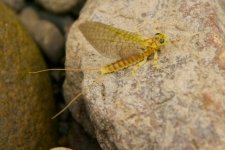DaveKile
Administrator
Staff member
This mayfly photograph was on the Little J at about 4:00 pm on May 20th. Pretty certain body was about 8-10mm.
Again, those just going thru the process for the first times here are some of the key indicators in identifying mayflies. Pcray1231 and sandfly have been real helpful here in this forum and are really good at this. Most of us go back to the books to verify many of the bugs we see, especially this year with hatches coing in so early. I was out with a few guys the other week, each with decades of experience and none of us called it right on the stream. Still need to look it up to get it right.
This one isn't easy, but give it a go to fill out as much data as you see and identify the mayfly.
Tails: 2 or 3
Fore wings: solid color or molted/spotted coloring
Hind wing: absent, obvious or minute (small nub behind fore wing)
Body length:
Hind wing costal bump: present or absent
Flat head: yes or no
Time of day:
Date:
Body Color:
Again, those just going thru the process for the first times here are some of the key indicators in identifying mayflies. Pcray1231 and sandfly have been real helpful here in this forum and are really good at this. Most of us go back to the books to verify many of the bugs we see, especially this year with hatches coing in so early. I was out with a few guys the other week, each with decades of experience and none of us called it right on the stream. Still need to look it up to get it right.
This one isn't easy, but give it a go to fill out as much data as you see and identify the mayfly.
Tails: 2 or 3
Fore wings: solid color or molted/spotted coloring
Hind wing: absent, obvious or minute (small nub behind fore wing)
Body length:
Hind wing costal bump: present or absent
Flat head: yes or no
Time of day:
Date:
Body Color:




